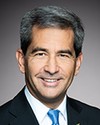Thank you.
Mr. Chair, I very much appreciate the opportunity to be here and to introduce myself to all of you as the new senior associate deputy minister of national defence.
This is day 17. Over the past three weeks, I've had the feeling of being on new but familiar ground. I am the daughter of an admiral. My father retired as vice-chief of the defence staff. My husband served in the regular and the reserve force, and is a medically released commander in the navy. My brother-in-law is a serving major-general.
I am also a commissioned officer. I joined the naval reserve as a high school student, through what was then known as the summer youth employment program.
I was in one of the first cohorts of women in the naval reserve to be allowed to have a so-called hard sea trade, and I chose to be a diesel mechanic. I was not a fantastic diesel mechanic.
Then, upon entering university, I applied to, and was accepted into, a three-year officer training program. When I graduated, I trained officer cadets to be maritime surface and subsurface officers, the officers who command, coordinate, and control military maritime operations and who help inform the design, procurement, and evaluation of ships, submarines, and naval systems.
I learned a lot from that experience. Indeed, I attribute much of my resilience to my time in the navy.
My ability to see where we are, where we need to be, and how to get there safely is unequivocally a gift from my time in the navy. Both have served me incredibly well in the various management leadership roles I've held in the public sector.
My first foray into the public sector was as chief of business planning and administration for the Atlantic region of what was then Public Works and Government Services Canada. I then moved to the other side of the country, where my husband was posted, and became the business manager of the Esquimalt graving dock on the west coast. It was a busy place. As the only open-access, multi-user facility on the west coast of the Americas, and the largest deep-sea shipbuilding and repair facility on Canada's Pacific coast, we welcomed big ships from around the world, from cruise ships and general cargo vessels to B.C. ferries and Royal Canadian Navy warships.
Turning my attention away from the water for a few years, I joined Passport Canada in 1995. There, I held several positions, including manager of the Victoria passport office, director of security operations, and director general of security. Most notably, however, I took on the role of chief operating officer at the height of the 2007 passport crisis.
That year, new international travel policies left Canadians who wanted to fly to the United States scrambling to get passports. The department was woefully unprepared for the surge in demand. In January alone, we received 23,000 more applications a day than we did the month before. By May, we had a backlog of almost 200,000 applications. My job was to turn it all around.
In the months that followed, I undertook an immense restructuring of the services in each province and territory. We put in place new processes. We built a new centre for printing passports, and we hired new personnel. Two years later, the then-Auditor General of Canada, Sheila Fraser, tabled a status report. In it, she said she was “pleased at the extensive action it [Passport Canada] has taken to fix the problems”. I was pleased too, and it remains one of the highlights of my career.
Another highlight was my tenure as the commissioner of the Canadian Coast Guard.
I worked every single day with the armed forces in that job, and I am also honoured to have been the first woman to lead the Canadian Coast Guard.
Obviously, there are many differences between the two institutions, yet they share a unique operational component. As the head of the government's civilian fleet, I oversaw an organization that every single day saves 15 lives, responds to 27 search and rescue cases, manages the movements of 1,233 vessels, carries out 11 fisheries patrols, supports 8 scientific surveys and 3 hydrographic missions, surveys 3.5 kilometres of channel bottom, and contributes to the work of numerous other government departments.
I was, and continue to be, incredibly proud of the work of the Canadian Coast Guard's 5,000 employees.
On a personal level, I am also proud that during my two years at the helm I was able to document the case for increased funding for the Coast Guard. I was able to make the organization more relevant to communities across the country. My team and I were able to show Canadians just how extraordinary this organization is, even as we streamlined our operations, renewed our fleet, and explored how we could better deliver our range of essential and critical services.
Another significant challenge I faced at the Coast Guard was managing the psychological impact of operations. A particularly difficult time occurred while I was deputy commissioner of operations. As many of you may remember, a Coast Guard helicopter crashed in the Arctic four years ago, killing all three people on board.
The incident affected everyone in the agency, and it really underscored for me the importance of ensuring both the mental and the physical well-being of our employees, many of whom face difficult situations on the job and see the worst possible scenarios at work, and some of whom deal with difficult situations at home, as well.
It's why I am now the champion of mental health at the Department of National Defence. I know the pain of people who have lost colleagues on an operation. I've seen the devastation of suicide on family and loved ones, and I can attest to how initiatives like a local one in this city, Do it For Daron, can really make a difference in people's lives.
My primary responsibility, however, is to help ensure that the Department of National Defence can tackle the four big challenges it faces. First, is its huge implementation agenda; second, is the quick and complete application of the new defence policy when it's launched; third, is the exacting, judicious, and strategic use of Canadian tax dollars; and finally, we need to further close the seam between the Canadian Armed Forces and Veterans Affairs Canada.
I feel well-positioned to help do that. I understand the structure of the department and the Canadian Armed Forces. I have a lot of experience balancing service delivery and security, and I have great internal advisers who can give, and have given, me a solid footing on the issues.
I look forward to taking those issues on, and building a department that serves soldiers, sailors, air personnel, military families, and Canadians across the country.
Thank you for your time, and I'd be pleased to answer any questions.




